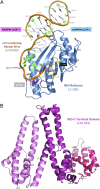Molecular basis of antibiotic multiresistance transfer in Staphylococcus aureus
- PMID: 23359708
- PMCID: PMC3581901
- DOI: 10.1073/pnas.1219701110
Molecular basis of antibiotic multiresistance transfer in Staphylococcus aureus
Abstract
Multidrug-resistant Staphylococcus aureus infections pose a significant threat to human health. Antibiotic resistance is most commonly propagated by conjugative plasmids like pLW1043, the first vancomycin-resistant S. aureus vector identified in humans. We present the molecular basis for resistance transmission by the nicking enzyme in S. aureus (NES), which is essential for conjugative transfer. NES initiates and terminates the transfer of plasmids that variously confer resistance to a range of drugs, including vancomycin, gentamicin, and mupirocin. The NES N-terminal relaxase-DNA complex crystal structure reveals unique protein-DNA contacts essential in vitro and for conjugation in S. aureus. Using this structural information, we designed a DNA minor groove-targeted polyamide that inhibits NES with low micromolar efficacy. The crystal structure of the 341-residue C-terminal region outlines a unique architecture; in vitro and cell-based studies further establish that it is essential for conjugation and regulates the activity of the N-terminal relaxase. This conclusion is supported by a small-angle X-ray scattering structure of a full-length, 665-residue NES-DNA complex. Together, these data reveal the structural basis for antibiotic multiresistance acquisition by S. aureus and suggest novel strategies for therapeutic intervention.
Conflict of interest statement
The authors declare no conflict of interest.
Figures




References
-
- Chang S, et al. Vancomycin-Resistant Staphylococcus aureus Investigative Team Infection with vancomycin-resistant Staphylococcus aureus containing the vanA resistance gene. N Engl J Med. 2003;348(14):1342–1347. - PubMed
-
- Centers for Disease Control and Prevention (CDC) Vancomycin-resistant Staphylococcus aureus—Pennsylvania, 2002. MMWR Morb Mortal Wkly Rep. 2002;51(40):902. - PubMed
-
- Werner G, Strommenger B, Witte W. Acquired vancomycin resistance in clinically relevant pathogens. Future Microbiol. 2008;3(5):547–562. - PubMed
-
- Weigel LM, et al. Genetic analysis of a high-level vancomycin-resistant isolate of Staphylococcus aureus. Science. 2003;302(5650):1569–1571. - PubMed
Publication types
MeSH terms
Substances
Associated data
- Actions
- Actions
Grants and funding
LinkOut - more resources
Full Text Sources
Other Literature Sources
Medical

